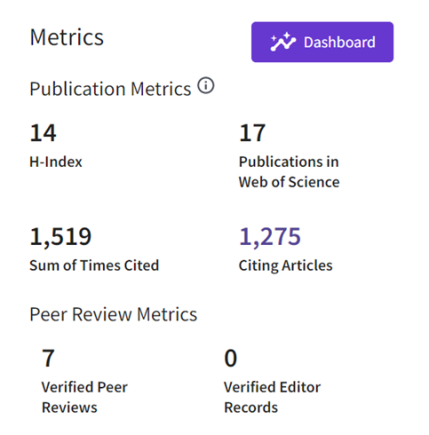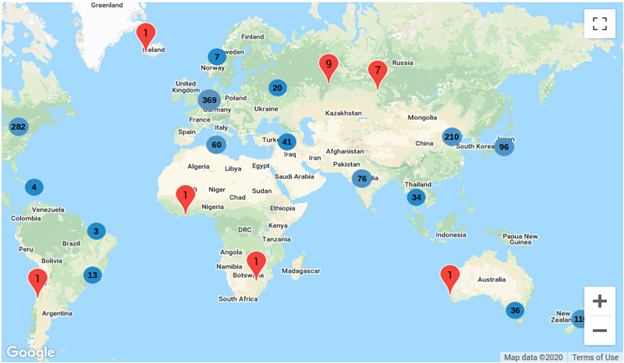Web of Science Researcher Profile Metrics
On the right-hand side of your Web of Science researcher profile, you will see a metrics sidebar once you have populated your profile by adding some publications, reviews or editor records .

Publication Metrics
Aggregate publication metrics displayed on your Web of Science researcher profile are derived from citations awarded only to your Web of Science Core Collection indexed papers. This means that some papers indexed in other Web of Science collections may have individual citation counts that do not contribute to these aggregate metrics.
-
H-Index: you have an H-Index of N if you have at least N publications with at least N citations.
-
Publications in Web of Science: the number of publications on your profile which are indexed in the Web of Science Core Collection .
-
Sum of Times Cited: the sum of citations your Web of Science Core Collection documents have received from the Web of Science Core Collection.
-
Citing Articles: the number of documents in the Web of Science Core Collection which have cited the Web of Science Core Collection documents on your profile.
Peer Review Metrics
-
Verified Peer Reviews: the number of peer review assignments you have added to your profile which have been verified. Click here to read more about review verification.
-
Verified Editor Records: the number of handling editor records you have added to your profile which have been verified. Click here to read more about review verification.
Author Impact Beamplot Summary:
-
Your Author Impact Beamplot Summary displays the lowest, highest, and median field and year normalized citation percentiles among your publications. It gives an at-a-glance overview of the impact of your publications.
Author position and author network:
These metrics are based on the documents we have successfully matched to you in the Web of Science Core Collection which may not exactly match the documents added to your profile. We are not always able to match you successfully to every Web of Science Core Collection document in your profile. If you believe that we have failed to do so, please let us know
-
Your author position graph demonstrates the proportion of your Web of Science Core Collection publications of which you were first, last, or corresponding author.
-
Your author network displays the 5 authors you have most often co-authored with and the number of times you have collaborated with them. Your author network is only displayed once you have 5 Web of Science Core Collection documents on your profile.
Citation counts shown on your researcher profile are from the journals, books, and conference proceedings indexed in Web of Science Core Collection. The 21,000+ journals indexed are hand-selected and evaluated by expert editors. These citation counts are displayed per-publication and used for derivative metrics such as h-index and Sum of Times Cited. We do this because we know that every citation we count is from content that has been vetted by expert editors as meeting the quality standards required to be indexed in the Web of Science Core Collection.
This means the citation counts on your profile may be lower than e.g., Google Scholar but that the source of those citations are known and vetted. This does not mean that uncounted citations are all illegitimate, but it does mean you can be sure that no illegitimate citations are ever counted.
You will see these citations in the following places:
-
Alongside your publications on your public profile
-
In Web of Science document search (available to entitled users only)
-
On full record pages (e.g. https://www.webofscience.com/wos/woscc/full-record/WOS:A1972N831000009)
-
Alongside the publications you’ve reviewed in your review history
-
Alongside your publications in your publication history
-
Alongside the publications you’ve handled as editor in your editor record history
Papers that cannot be found in the Web of Science Core Collection will display “Not indexed” instead of a citation count.

A citation count of '0' indicates that we have found that paper in Web of Science but that there are no citations recorded for it there.
You can access your Metrics Dashboard by clicking on the ‘Dashboard’ button found on your profile metrics sidebar.

Publication Metrics
-
Publications in Web of Science
-
Sum of times cited
-
h-index
Times cited and publications over time
This graph is comprised of a histogram of your Web of Science Core Collection documents per-publication year and a line graph of the citations your documents received in those years.
-
View citation report: if you are entitled to the Web of Science Core Collection you may click through from here to “View citation report.” Please note that the documents used to generate that citation report will only be those we have successfully matched to you in the Web of Science Core Collection
Author Impact Beamplot:
Beamplots were devised by Lutz Bornmann and Robin Haunschild (Max Planck Institute, 2018). The Institute for Scientific Information (ISI) has promoted beamplots as an alternative to the h-index in Profiles not metrics (2019). The following are benefits of beamplots:
-
Contextualizes a researcher’s articles to make them suitable for comparison
-
You can see performance change over the course of a researcher’s career
-
Evaluators can see performance change over the course of a career
-
Discourages reliance on a single-point metric that lacks context and nuance
With Web of Science Core Collection entitlements, you can view others’ author impact beamplots on their researcher profiles. Without those entitlements you may only view your own.
For more information, visit our help page on Beamplots.
Geographic Citation Map
Your geographic citation map shows you the locations across the world from which other researchers have cited your Web of Science Core Collection documents. Those coordinates are based on the institutions with which their authorships are affiliated.
With Web of Science Core Collection entitlements, you can view others’ geographic citation map on their researcher profile. Without those entitlements you may only view your own.
Peer review metrics
-
Verified peer reviews shows the total number of verified reviews you have added to your profile.
-
Verified peer reviews (last 12 months) shows the number of verified reviews you have added to your profile and completed in the last year.
-
Peer review to publication ratio indicates the ratio of verified peer reviews to papers published
Reviews per month
A graph showing the number of verified reviews you have completed either per-month or cumulatively on a month-by-month basis.
Average review length
A graph showing the average word count among reviews for which you have added the review content. You can add review content on each review’s edit page.
About the h-index
Your h-index is calculated using citation data from Web of Science Core Collection, based on the publications you have added to your researcher profile. Only Core Collection publications and citations (including self-citations) are included in the h-index calculation.
The h-index (also known as Hirsch index) was introduced by J. Hirsch in 2005 and can be defined as follows: A researcher has an h-index, if they have at least h publications for which they have received at least h citations. For example, Researcher A has an h-index = 13 if they have published at least 13 documents for which they have received at least 13 citations.
Use the h-index responsibly
The h-index’s popularity as a bibliometric indicator is because it is simple to calculate and combines measures of productivity (number of published articles) and impact (number of citations) in one index. When used alongside other measures, it can quickly indicate how citations are distributed over a researcher’s publications.
This popularity has led to misuse — particularly when it is treated as proof of productivity and impact, rather than a potential indicator of productivity and impact. Due to differences in publication and citation behavior between fields (even closely related fields) and because the h-index does not control for career-stage, it is unwise to draw any serious conclusions from h-index comparisons between researchers.
We are aware that many researchers and institutions use the h-index, while others prefer not to because of the tendency for it to be misused. We encourage researchers to become familiar with the scope and limitations of the h-index as an indicator.
Your citation map is a geographic representation of your citations across the globe. It demonstrates the international reach of your publications and highlights areas where your impact is more pronounced.

Your map can be accessed from your Metrics Dashboard. Red pins can be clicked to see the details of citing papers from a given location. Blue circles can be clicked to zoom in and de-cluster a point to see red pins and details of citing papers. Citing paper details for a given city are grouped by institution.
Citing paper locations are based on the institutions its authors were affiliated with at the time of its publication. A given citing paper may be represented several times on a map if researchers from multiple institutions contributed to it. This means that the number of points indicated on the map may be higher than your total citation count.
All citations are sourced from the Web of Science Core Collection only. If we display “Not indexed” alongside your publication that indicates that we are unable to find a record of this paper in the Web of Science Core Collection.
A citation count of “0” indicates that we have found that paper in Web of Science but that there are no citations recorded for it there. If your publication is not indexed in the Web of Science, we are unable to retrieve citations for your publication.
If you believe your publication should be indexed (journal is indexed) but is not yet indexed in the Web of Science, you may request data corrections by the Web of Science using this the data change request form.
Note: The Web of Science Core Collection only indexes "Early Access" articles for several journals. Early Access articles are 'version of record' publications made available to access, read, and cite before they are assigned a final volume, issue, or final publication date. Articles will usually be indexed in the Web of Science Core Collection once it is published in a standard issue of the journal.
